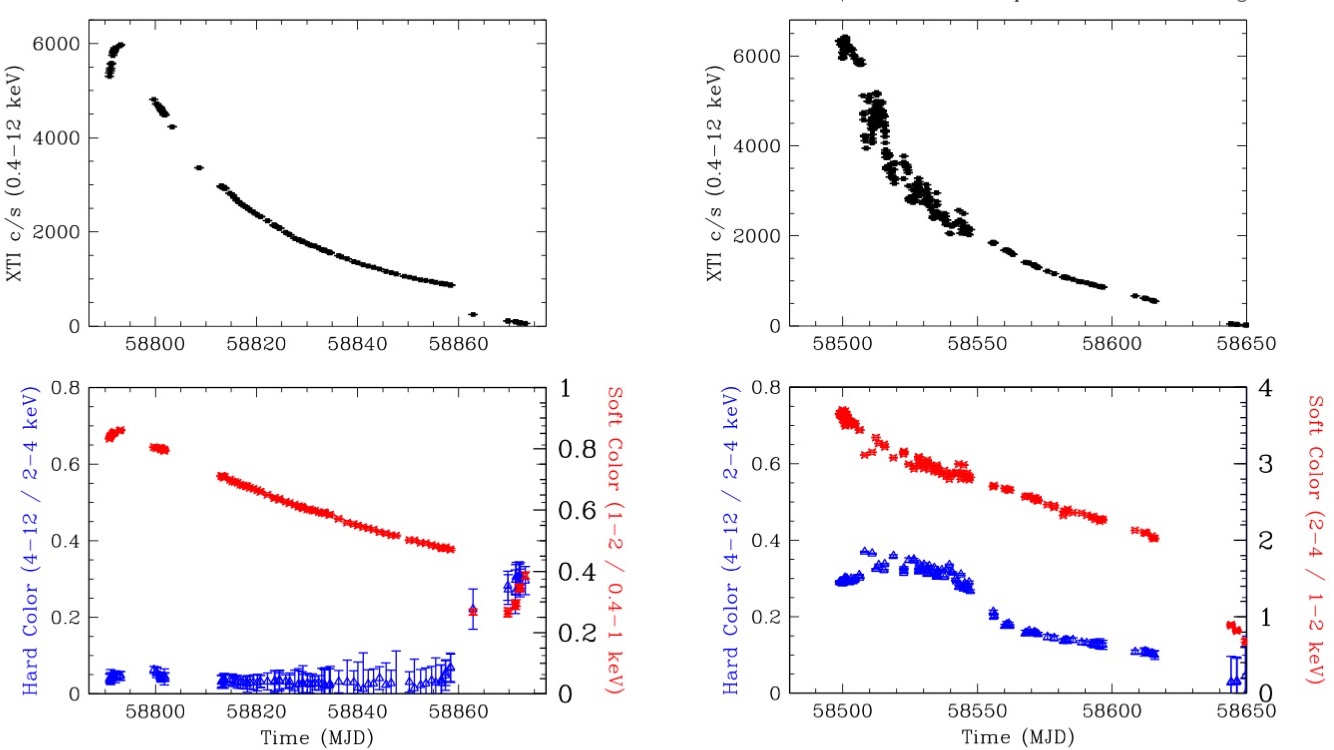NICER / ISS Science Nugget
for January 30, 2020
NICER Observes the Unusual Black Hole Binary MAXI J0637-430
The NICER Science Team submitted an Astronomer's Telegram (ATel#
13427) today, announcing a state change in a peculiar X-ray
transient in the Milky Way. MAXI J0637-430, discovered on 2019 Nov 2, had been classified as an X-ray binary system on the
basis of double-peaked optical emission lines (H and He) that signify the red-shifted and blue-shifted halves of a rotating
accretion disk. The X-ray spectral shape and the value of X-ray to optical luminosity (> 1000) supported the idea that the
accreting compact object is a black hole.
The brightness track of MAXI J0637 over the last ~3 months follows the classic decay curve of an X-ray transient, but the
serene manner of its evolution has not been seen before. In the Figure, the light curve of MAXI J0637 is contrasted with the
recent (2018) outburst from MAXI J1631-479. The latter source displays more of the fluctuations that we usually see from
turbulence in the inner accretion disk. In fact, we find no local X-ray variations at any timescale (ms to an hour) in MAXI
J0637 during any observation through 2020 Jan 10. This is a case where "serene" is disturbing to the astronomers!
Beginning on Jan 14, the NICER data show a change in the spectral state: there is an abrupt drop in the intensity (Figure,
top-left panel), the X-ray colors shift (bottom-left) in a manner that suggests a pivoting of the spectrum to a new shape,
and the typical short-term variability (ms to an hour) switches on. These characteristics indicate that MAXI J0637 has
entered the "hard state", where bipolar jets are likely to be operating in this system. That is the news conveyed by the
NICER team in the submitted Telegram.

Figure:
(Left) MAXI J0637-430 intensity history (top) and spectral colors (bottom) during its current outburst. The smooth intensity
maximum and decay is quite atypical for black hole binary systems, The 2018 outburst from MAXI J1631-479 (right) shows the
more typical local variations that we expect from a turbulent accretion disk. Other sources show multiple maxima and strong
flares that change colors. Toward the end of the outburst of MAXI J0637, there is a sudden drop in intensity and higher color
values that signify a state transition and the possible emergence of a jet. This is the topic of the Telegram that the
NICER team submitted today. The quiet character of this black hole before the transition remains a topic of investigation.
As we investigate the properties of the jet, we are still left with the question of the quiet character of MAXI J0637 at
times before the state transition. What suppresses the turbulence in the accretion disk? Possible solutions seem to be
radical conjectures. Are magnetic fields somehow suppressed in the MAXI J0637 accretion disk? Is the cause of accretion
something different from a binary system, e.g., the improbable tidal capture of a passing star by an isolated black hole?
These and other scenarios need further consideration.
<< Previous
Main Index
Next >>